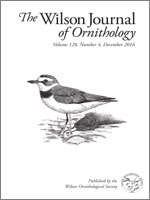We provide the first detailed account of incubation and nesting behaviors of Carmiol's Tanagers (Chlorothraupis carmioli) based on 34 nests of the subspecies Chlorothraupis carmioli frenata found between 2008 and 2011 in Manu National Park at 400 and 1100 m above sea level. All nests were shallow cups with three layers. All nests had two white eggs with varying intensity of brown speckling. The parent spent 63.9 ± 11.6% (average ± SD) of the daylight period incubating and conducted 5.6 ± 2.3 (n = 73 days) off-bout trips per day that lasted 52.6 ± 22.9 min (n = 409 trips). The incubation period ranged from 15 to 17 days. Nestlings hatched weighing on average 4.2 ± 0.8 g (n = 8 nestlings) and gained 2.5 ± 0.1 g per day (n = 63 nestling-days). The nestling period lasted 11 days. Mass the day before fledging was 24.7 ± 2.1 g (n = 3 nestlings). Nest shape and composition, egg coloration, and clutch size of C.c frenata subspecies was very similar to the nests described for Central American subspecies C.c. carmioli. We additionally compared our results within the newly formed Habia-Chlorothraupis clade. Our results provide additional support for the phylogenetic relationship suggested by Klicka (2007) in which H. rubica is the closest relative of the Chlorothraupis genus.
How to translate text using browser tools
1 December 2016
Nesting Biology of Carmiol's Tanager (Chlorothraupis carmioli frenata) In Southeastern Peru
Simon O. Valdez-Juarez,
Gustavo A. Londoño
ACCESS THE FULL ARTICLE
breeding
eggs
incubation brooding
nest
nestling
predation





